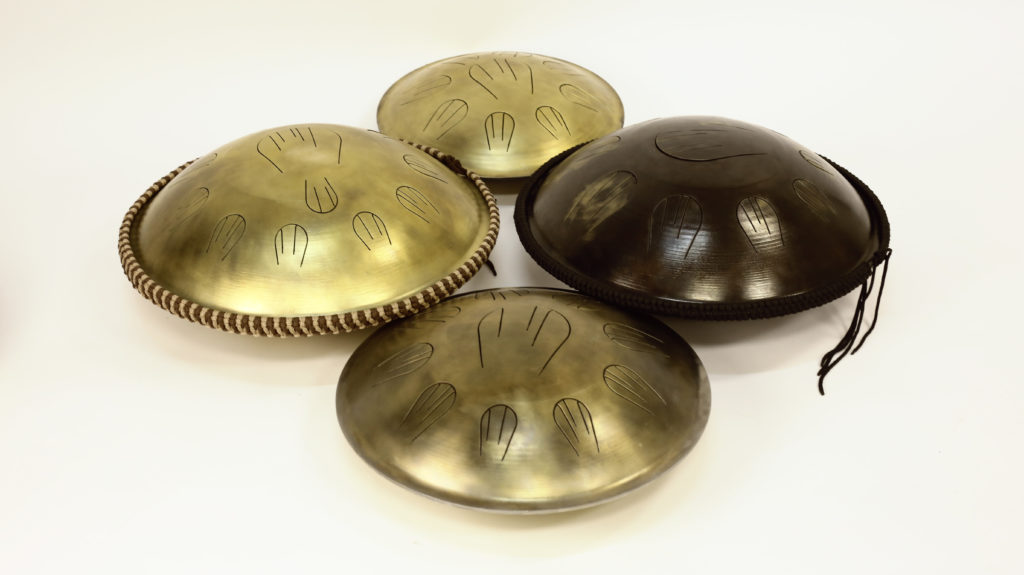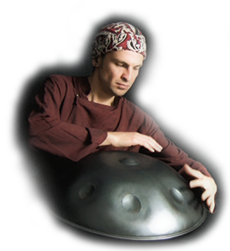
Nadishana, interview for the "Koha Ditore" newspaper, Prishtine, Kosova
1. What's special on ethno music?
Well, just the fact that for thousands years there was no other music on earth besides ethno music. It's an immense amount of knowledge accumulated by generations of masters in different cultures. I think It makes ethno music interesting enough for anyone who's serious about music in general.
2. How did you start experimenting with instruments? (A detailed story about first steps, challenges, triumphs)
I started my musical self-education in 90s. There were no internet and no info about ethnic music then. Nowadays you can go to some supermarket and buy a djembe or a jaw harp. But that time in Russian province you couldn't buy any ethnic instruments. Nobody even heard about such a thing. But that was the time when I just got some tapes with amazing traditional music from India, Africa, Indonesia etc. That was a revolution in my mind. I understood, that what we usually define as "music" is probably just 1% of amazing variety which exists in reality.
On that tapes they were playing on some unbelievable instruments producing fascinating sounds. And you couldn't understand how these instruments look like, how they work, what is the construction or how the sound is produced. The only way to have instruments that time was to make them yourself from anything what you can find around you. And then also find your own way of playing, because there was no one who could teach you.
Well, me and my friend were trying to reproduce somehow the sounds we heard, and we began to make weird instruments from tins, bottles, springs, plates, water tubes, rubber bands, ceramic pots, shellac disks..
We were so obsessed!
Regarding the challenges I can give you some examples.
That's how I made my 1st "dumbek". 1st of all you should understand the construction of the instrument. Since there was no internet, to see the real instrument you had to travel to visit one of 2 instruments museums, in St. Petersburg or in Moscow. There you could see which shape of the body is traditionally used and how to put straps etc. Then you had to get a ceramic body and a specially treated drum skin. I made a deal with my friend from ceramic factory and she got an unprocessed ceramic vase for me. The security was patrolling the factory wall, so we had to wait until they would pass and then my friend passed me the vase over the wall. After this I had to go to the workshop of another friend, who has cut the bottom of the vase on a machine. Then I managed to get a key from the room where they were stored old pioneer drums. Some of the drums had skin on the top, so I could get these skins. As the last step I had to put that skin on the vase with the glue and straps. So whole thing use to take a lot of time and effort as you can imagine.
Another story of making my 1st kalyuka (Russian overtone flute). This is an ancient instrument from Russia, but unfortunately the tradition is lost in our country. There's no native players anymore and even no records of.the music which was played on this flute were left.
I heard kalyuka for the first time on a concert of the famous russian folklore singer Sergey Starostin. I was instantly fascinated by the sound and by the fact that this flute can produce the full diatonic scale without playing holes. But from a big distance between me and stage I couldn't see the construction of the embouchure of course. So I was experimenting for about 2 weeks with some water pipes and constructed the flute which was sounding very similar. I made the U-shaped cut on top of the tube and I thought I understood the construction of kalyuka. Only some years later I discovered that kalyuka has totally different mouthpiece. But my version was actually much better in terms of articulation and variety of possible techniques. In the end I also developed my own technique of playing on this flute, because again it was no choice. I heard kalyuka only once on a concert and that was too short to remember anything.
3rd example: I was trying to make a kind of "balafon" out from coffee tins. Some of them have a very clean tonal sound, when they are played on a bottom by a stick. During my experiments I discovered that they can be fine tuned by children's clay.
So I collected about 15 coffee tins and made a set of them which was sounding really great and unique but of course not even close to the real balafon.
You had to be very creative and persistent in order to continue with that kind of music that time in Russia.
So I'm very grateful to this hard period of my life. The lack of information immensely helped me. During all those experiments with instruments making I discovered one very essential thing for the musician: the instrument is not what is most important. The most important is the music inside yourself and your ability to express it through your body. This is what I call musicianship.
Nowadays the price that you pay for the information is tending to zero. You can download everything in one click for free. But before digital technologies came, one had to pay a very high price for the information and knowledge. In fact, it was much more expensive than money, you were paying with your life. At least at the place where I grew up. And I still prefer to pay this price. Here's a second lesson I learned that time: only a hard earned knowledge becomes a real part of you.
3. I read there are around 200 instruments you can play? How is this possible? Don't you get confused?
There's a very simple reason why I play so many instruments. That time in 90s there were no musicians around to play my music with me, but I really wanted it to be out on a record. The only way to make it happen was to learn all parts on all instruments yourself and overdub them one by one. Of course this is a very inefficient and hard way to produce music, but there was no other option. When I was learning to play these instruments I even wasn't thinking that I will play them live at some point. That time in Russia there was no market for this kind of music, people even wouldn't understand that this is actually music!
The most challenging aspect of this approach came years later, When I eventually found musicians to play with and was trying to change contrast instruments (strings, winds, percussion) on stage during the concert, I discovered that this is really hard because you don't have a warm up time. I'm working on this issue many years but still that's the most hard aspect of multi-instrumentalism for me.
4. Learning to play different instruments, gave you also an opportunity to explore different cultures?
I would say it's other way round: the fact that I discovered that in other countries people still have their traditional culture made me learn their instruments. Here in Kosovo you are surrounded by rich traditional cultures: albanian, serbian and turkish, but in Russia we don't have such a privilege anymore. Orthodox church started to destroy it thousand years ago and then communists effectively finished destroying the rest which was still left.
So generations of people in Russia are born without any clue what the traditional culture is about. Unfortunately we have only entertainment industry in our country, the cheap artificial substitute of the culture.
So when I first heard some traditional music from Asia and Africa it was a completely new experience for me. I felt that those people have the kind of knowledge which I had never met before. I felt that there's some fundamental truth in their music and I want to know why and how do they do that. That's how I actually started with ethnic instruments.
5. Which is one of the instrument you love the most? Which one's the hardest to handle?
My favorite instruments are the ones that I elaborated myself, with my friends, or modified ones: dzuddahord, futujara, hybrid kaval, water udu, darbudu, duclar etc. Those instruments have quite unique sound and there's no tradition behind them. This opens up a lot of creative possibilities. This is the most natural way to develop my own unique style of playing for me, because these instruments feels fresh and unexplored.
The hardest to handle so far is the hybrid kaval. First of all because it is very hard just to produce a sound from this flute. It took me about 2 weeks of practice just to get the first sound! Another difficult factor is that I play multiple styles on this flute (in a corner of the mouth, on front teeth, on a 3rd tooth). The intonation and style switching on this instrument is a whole science, and its acoustics is a mystery, which is beyond my understanding so far.
6. How was the experience in Kosovo?
I enjoyed a lot although I was there only 1 day. That was really great to meet local musicians and to play with them. That's actually my favorite way to travel: going to different places to play with musicians from different traditions.
7. Are you on tour the whole time? Which are the next stations?
I'm on tour a big part of the year. Next will be tour in Estonia with David Kuckhermann, then Russia with 7/8 Band, then Poland, where I play solo program and hold a workshop, after that France with Loup Barrow and Manu Delago.
8. As a musician, do you consider that ethno music has enough space in music industry?
I don't really know because I'm not a part of this industry. I don't think that ethno music necessarily needs space there. It was doing fine without any industry for thousands of years and it will be still there after the industry.
9. Who taught/helped you to handle the instruments you play?
I'm self-taught. That time in Russia it was impossible to find a person who could teach me the things I wanted to study. I was learning by listening to many records. I call that "structural listening". When I hear any music I always try to "take it apart" in my mind (style, form, parts, timbres, ornamentations, melody, harmony, time signature etc.). That way you can understand how different music works, or why it's not working. Of course the same way one should analyze own playing, I think. Since I have a lot of instruments, I am spending a lot of time practicing. Also I always try to play with musicians who's better than me, this is priceless experience if you want to grow up as a musician.
10. What's the role of music in your life?
It is a very essential role. I use music to create, to develop myself, to communicate with other people, to find people I need. With the help of my music I'm bringing into my life things I want.
It's a well known fact that music can bring us to other worlds faster then anything else. You listen to some music for only few seconds and you're instantly in a different reality!
This effect is even much more powerful if you create music yourself. I think that music is a 'reality generator' and that describes its role in my life.
Interview by Elvira Berisha.










 News
News






